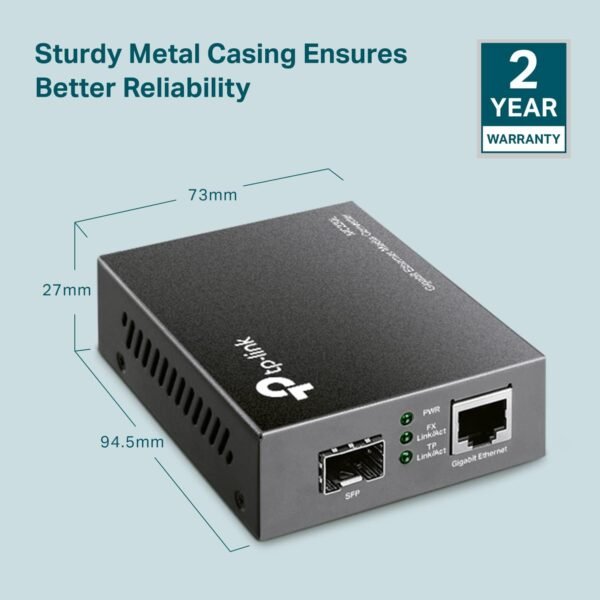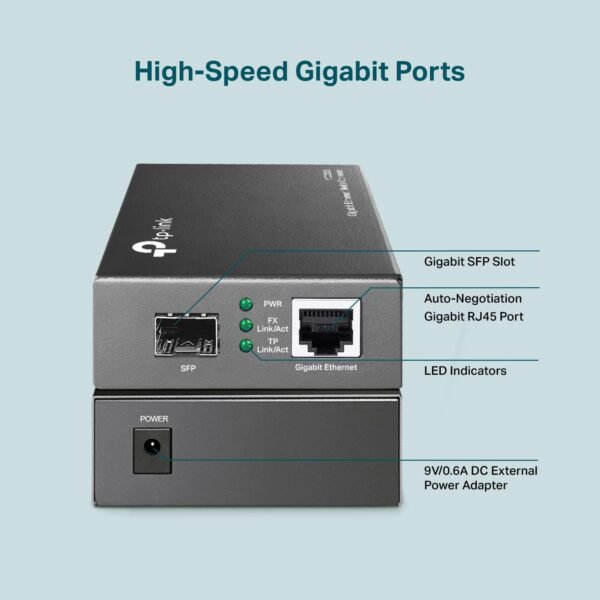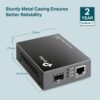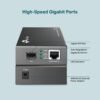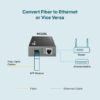Comprehensive review of TP-Link MC220L fiber to Ethernet media converter
Comprehensive review of TP-Link MC220L fiber to Ethernet media converter
- Sturdy metal casing provides excellent durability, making it suitable for long-term use in various environments.
- The plug-and-play functionality ensures a seamless setup process, eliminating the need for complicated configurations.
- Compatible with a wide range of SFP modules, offering excellent versatility for different networking setups.
- Reliable and consistent performance, even over extended distances, gives confidence in its operation.
- The compact design allows for easy placement, whether used as a standalone device or within a system chassis.
As an Amazon Associate I earn from qualifying purchases.
Description
Reliable Fiber to Ethernet Conversion with the TP-Link MC220L
I recently got my hands on the TP-Link MC220L, and I must say, it’s a practical piece of networking gear that delivers exactly what it promises. It’s primarily designed to handle fiber-to-copper or copper-to-fiber conversions, and if you’re dealing with Gigabit Ethernet needs, this device is a lifesaver.
Straight out of the box, it exudes a solid build quality with its durable metal casing. It’s compact enough to fit into tight networking setups, and while it may not be flashy, it gets the job done without any unnecessary bells and whistles. I tested it alongside a mix of single-mode and multi-mode fiber setups, and the compatibility was seamless, making it a versatile tool in my networking arsenal.
Ease of Use: Plug and Play Simplicity
One of the standout features of this media converter is its plug-and-play capability. There’s no need to fiddle with configuration software or drivers. I simply plugged in the fiber and Ethernet cables, and the device was up and running instantly. The auto-MDI/MDIX feature is a godsend, especially when working with various cables and setups—it eliminates the guesswork.
The front panel LED indicators were incredibly helpful too; they made it easy to monitor the connection status at a glance. Whether it was in full-duplex or half-duplex mode, the auto-negotiation functionality ensured a smooth connection without any manual intervention.
Positives
There are some fantastic aspects about this media converter that I appreciate:
- Highly compatible with multiple fiber types: It works with both multi-mode and single-mode fiber modules, offering flexibility for different setups.
- Extended range capabilities: With the right SFP modules, it supports transmission distances up to 20km (12.4 miles) for single-mode fibers and 550m (1,800 feet) for multi-mode fibers.
- Compact and durable design: The metal casing ensures durability, while its small size makes it unobtrusive in any networking setup.
- Quick and straightforward installation: The plug-and-play feature makes it beginner-friendly.
Areas for Improvement
While this product is undeniably efficient, a few things stood out as potential weaknesses:
- No included SFP modules: You’ll need to purchase them separately, which can be inconvenient if you’re expecting an all-in-one solution.
- Limited to Gigabit speeds: It’s not suitable for anyone needing 10Gbps or higher throughput.
- Basic design: While functional, the lack of mounting options might bother those who prefer rack-mounted setups.
Performance and Compatibility
What really sold me on this converter is its versatile compatibility. I tested it with various brands of SFP modules, and it worked without any hiccups—no proprietary restrictions here, which is a big plus in my book. I tried connecting it to both 10/100/1000 Base-T Ethernet devices, and the performance was consistent across the board.
The hot-swappable FX port was another feature I appreciated. It made it easy to swap out modules without needing to power down the device, which is a massive convenience during maintenance or upgrades.
Competing Products
Compared to similar converters on the market, the TP-Link MC220L holds its own. For instance, I’ve used converters from Netgear and TRENDnet in the past, and while they offer comparable performance, they often come at a higher price point or lack the hot-swappable capability.
On the flip side, some models from Ubiquiti offer enhanced management features, but they require software configurations, which makes them less user-friendly. The plug-and-play simplicity of this TP-Link device is a winning point for anyone who prefers hassle-free setups.
Value Proposition
In terms of cost efficiency, the MC220L strikes a great balance between price and performance. It’s not the cheapest option out there, but the features it packs—like long-range fiber support, auto-negotiation, and multi-mode compatibility—make it worth every penny.
Other converters might offer similar specs, but they often lack the durability and ease of use you get here. If you’re in the market for a no-nonsense media converter that delivers reliable performance, this one is hard to beat.
Additional information
| Product Dimensions | 3.72 x 2.87 x 1.06 inches |
|---|---|
| Item Weight | 0.16 ounces |
| Item model number | MC220L |
| Is Discontinued By Manufacturer | No |
| Manufacturer | TP-Link |


